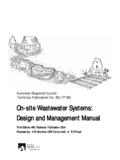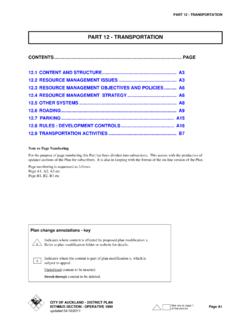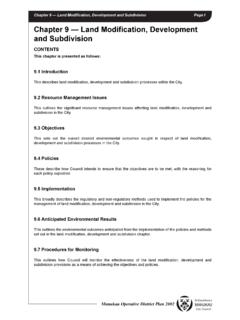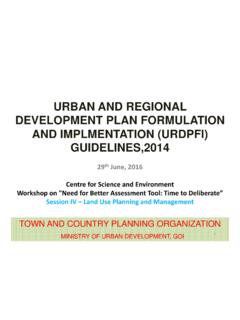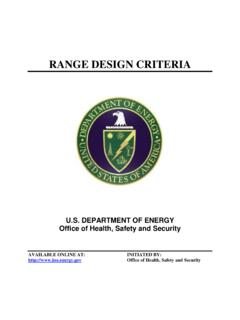Transcription of Guidelines for stormwater runoff modelling in the Auckland ...
1 Guidelines for stormwater runoff modelling in the Auckland Region April 1999 TP 108 Prepared for Auckland Regional Council by Beca Carter Hollings & Ferner Ltd Auckland Regional Council Technical Publication No. 108, April 1999 ISSN 1172-6415 Printed on recycled paper ARC Guidelines for stormwater runoff modelling i Auckland Regional Council Technical Publication No. 108, April 1999 CONTENTS GLOSSARY ii DEFINITION OF SYMBOLS iii 1. INTRODUCTION 1 Model Overview 1 Limits of Application 3 2. RAINFALL 4 Temporal Pattern 4 Design Rainfall Depth 4 Areal Reduction Factors 5 3. RAINFALL LOSSES 5 Rainfall- runoff Curves 6 Curve Numbers 7 4. runoff 11 Unit Hydrograph 11 Time of Concentration 12 5.
2 WORKED EXAMPLE 14 Catchment Details 14 Rainfall 15 Rainfall Losses 15 Time of Concentration 15 Model Input Parameters 16 Flow Results 20 6. GRAPHICAL METHOD FOR PEAK FLOW RATE 21 Introduction 21 Method 21 Worked Example 23 7. REFERENCES 26 Appendix A - Design rainfall maps Appendix B - SCS Guidelines for Curve Numbers Appendix C - Calculation Worksheets ARC Guidelines for stormwater runoff modelling ii Auckland Regional Council Technical Publication No. 108, April 1999 Glossary Antecedent ground condition Ground moisture condition preceding a storm event Average recurrence interval (ARI) Average period between exceedences of a given flow rate or rainfall ARC Auckland Regional Council Areal reduction factor Used to apply point rainfall estimates to large catchments Channelisation factor Used to reduce catchment response time to allow for higher velocities in engineered channels Cover type Landuse factor, eg.
3 Vegetation, bare soil, sealed pavement Curve number Defines the shape of the rainfall- runoff relationship and varies from 0 (no runoff ) to 100 (complete runoff ) Dimensionless unit hydrograph Hydrograph produced by a unit depth of rain excess falling uniformly in time and space over a unit area catchment Heterogeneous catchment Non-homogeneous catchment, eg: containing significant impervious areas draining by a separate piped network Homogeneous catchment A catchment where all areas drain through common flow paths Hydrograph Graph illustrating the variation of flow with time Hydrological condition Factor based on combination of parameters affecting catchment infiltration and runoff (vegetation density, surface roughness) Hydrological soil group Soil classification (A, B, C, or D) according to infiltration rate, where A is very high infiltration and D is very poor infiltration Initial abstraction Rainfall losses occurring before runoff begins (includes storage in depressions, interception by vegetation, evaporation, and infiltration)
4 Lumped catchment A catchment modelled as a single surface collecting rainfall, draining directly through a single outlet Potential soil storage Maximum water storage capacity of a soil Rainfall- runoff curves A family of curves developed by the SCS relating cumulative runoff to cumulative rainfall SCS Department of Agriculture, Soil Conservation Service (now known as the Natural Resources Conservation Service) ARC Guidelines for stormwater runoff modelling iii Auckland Regional Council Technical Publication No. 108, April 1999 Soil treatment Factor describing management of agricultural lands (eg: tillage, terracing) TR55 SCS Technical Release No. 55, urban Hydrology for Small Watersheds , June 1986 Temporal rainfall pattern Variation of rainfall intensity with time through a storm Time of concentration Time for a water particle to travel from the hydraulically most distant point of a catchment to the outlet Definition of Symbols A km2 Catchment area C - Channelisation factor c* - Dimensionless runoff index CN - runoff curve number I mm/hr Rainfall intensity I24 mm/hr 24 hr average rainfall intensity Ia mm Initial rainfall abstraction k - Hydrograph number L km Catchment length.
5 Measured along the main channel to the top of the catchment P mm Rainfall depth P24 mm 24 hr rainfall depth Q mm runoff depth q* m3/s/km2/mm Specific peak flow rate qp m3/s Peak flow rate S mm Potential soil storage Sc - Catchment slope calculated by equal-area method tc hrs Catchment time of concentration tp hrs Unit hydrograph time to peak V m3 runoff volume ARC Guidelines for stormwater runoff modelling 1 Auckland Regional Council Technical Publication No. 108, April 1999 1. Introduction These Guidelines present a recommended method for the application of the Soil Conservation Service1 rainfall- runoff model to catchments in the Auckland Region. They are based largely on Technical Release No.
6 55 (TR55) prepared by the Soil Conservation Service (SCS, 1986). The Soil Conservation Service (SCS) model has been selected for stormwater management design in the Auckland Region on the basis of an evaluation against gauged catchments (BCHF, 1999a, 1999b, 1999c). Those reports provide the background to the selection, calibration and validation of the method. Streamflow data from the gauged catchments have been used to select input parameters for the model (soil classifications, times of concentration, etc.) and to validate the model. The model is recommended for use in stormwater management design in the Auckland Region. It has been designed as a standard tool that will provide consistent results from different users.
7 It is suitable for: assessing the effects of landuse change, modelling both frequent and extreme events, applying to distributed (a network of sub-catchments) or lumped catchments and simulating natural systems as well as engineered systems (such as pipe networks). The model can be applied using a number of available software packages to predict runoff volumes, flow rates, and the timing of peak flows. Peak flow rates can also be estimated using an alternative graphical method. Model Overview Key features of the stormwater runoff model are illustrated in Figure and described below: Design 24 hour rainfall depths are provided in the form of rainfall maps covering the Auckland Region.
8 A standard 24 hour temporal rainfall pattern, having peak rainfall intensity at mid-duration. Shorter duration rainfall bursts with a range of durations from 10 minutes to 24 hours are nested within the 24 hour temporal pattern. runoff depth is calculated using SCS rainfall- runoff curves, with curve numbers determined from the SCS Guidelines according to classifications assigned to Auckland soil types. 1 now known as the Natural Resources Conservation Service, part of the Department of Agriculture. ARC Guidelines for stormwater runoff modelling 2 Auckland Regional Council Technical Publication No. 108, April 1999 Figure - Process diagram for the stormwater Model runoff hydrograph is calculated using the standard SCS synthetic unit hydrograph.
9 ARC Guidelines for stormwater runoff modelling 3 Auckland Regional Council Technical Publication No. 108, April 1999 Time of concentration is estimated using an empirical lag equation derived from a regression analysis of data from the Auckland Region. Separate analysis of pervious and impervious components of urban catchments. Effects of development on runoff depth are predicted using the standard SCS Guidelines . Effects on catchment time response are allowed for using a channelisation factor and runoff parameter in the time of concentration relationship. Limits of Application The model has been validated for relatively steep catchments in the Auckland Region, of up to 12 km2 in size, with little hydraulic storage.
10 For catchments with significant natural or engineered storage, separate hydraulic modelling of those areas will be necessary. The temporal rainfall pattern was derived statistically from rain gauge data representative of the Auckland Region and is appropriate for use within the Region. Rainfall loss and runoff timing parameters and have been validated for clayey (weathered mudstone and sandstone) and volcanic (granular loams, and loams underlain by fractured basalt) soil types. Other soil types should be modelled by interpolating the soil classification. The model is applicable to both rural and urban (or mixed) catchments. Model parameters have been validated for pasture, row crops and typical urban land cover.

